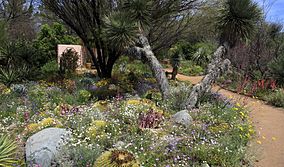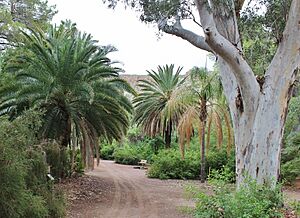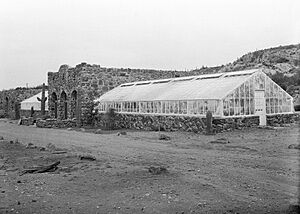Boyce Thompson Arboretum facts for kids
Quick facts for kids Boyce Thompson Arboretum |
|
|---|---|

Spring wildflowers at Boyce Thompson Arboretum
|
|
| Location | Pinal, Arizona, United States |
| Area | 392 acres (159 ha) |
| Elevation | 2,431 ft (741 m) |
| Established | 1924 |
| Named for | William Boyce Thompson |
| Governing body | Boyce Thompson Southwestern Arboretum Inc. |
The Boyce Thompson Arboretum is Arizona's largest and oldest botanical garden. It is also one of the oldest plant study centers west of the Mississippi River. This special place started in 1924. It was created to research desert plants and be a "living museum."
The Arboretum covers 392 acres (about 158 hectares). It sits in the Sonoran Desert next to Queen Creek. Above it towers Picketpost Mountain, which is an old volcano. You can find the Arboretum on U.S. Highway 60. It's about an hour's drive east from Phoenix. It is also 3 miles (4.8 km) west of Superior, Arizona.
The Arboretum has a visitor center and a gift shop. There are also research offices and greenhouses. You can explore a demonstration garden and a picnic area. A main trail, 1.5 miles (2.4 km) long, guides visitors. This trail leads through many different plant exhibits.
You can see a cactus garden and groves of palm trees. There are also eucalyptus trees. Other exhibits include plants from Australia and South America. There's an aloe garden and an herb garden too. Some side trails include the Chihuahuan Trail and High Trail.
Over 2,600 types of dry-land plants grow here. These plants come from all over the world. You can find agaves, aloes, and boojum trees. There are also cork oaks and jujube trees. The eucalyptus grove has "Mr. Big," one of the largest red gum Eucalyptus trees in the U.S. Many cacti and succulents grow throughout the Arboretum.
The Arboretum is a riparian zone, which means it has water nearby. This attracts lots of desert wildlife. Many migrating birds also visit the park. Visitors might see bobcats, javelinas, and coatimundis. You could also spot rattlesnakes or gila monsters. Hawks, hummingbirds, and vultures are common birds. Over 270 bird species have been seen here. The Audubon Society calls it an Important Bird Area.
Today, the Arboretum has 5,000 members. More than 75,000 people visit every year.
Contents
Discovering the Arboretum's Past
The Arboretum was started by William Boyce Thompson (1869-1930). He was a mining engineer who became very wealthy. He founded the Inspiration Consolidated Copper Company. He also started the Magma Copper Company.
In the early 1920s, Thompson loved the area around Superior. He built a winter home there, overlooking Queen Creek. As he became richer, he created two important places. One was the Boyce Thompson Institute for Plant Research in New York. The other was the Boyce Thompson Arboretum. It was built on his property near Superior, Arizona.
William Boyce Thompson had a big dream for the Arboretum. He wrote that he wanted to do more than just grow plants. He hoped to help Arizona by finding new useful plants. He wanted to gather plants from desert countries. Then, he would study their uses and share them with people. He aimed to make the desert lands more productive. He wanted to build the most beautiful and useful garden of its kind.
The Boyce Thompson Southwestern Arboretum officially began on April 1, 1924. Its first two employees were Dr. Franklin Crider and Frederick Gibson. They were both from the University of Arizona. Their first job was to build two homes. These homes, the Crider House and Gibson House, are still there today.
In 1925, buildings for growing plants were put up. By 1926, the Smith Building, used for administration, was built. Two greenhouses were also added. Ayer Lake was created that same year. It helped water the lower part of the park. In 1927, the Arboretum became a non-profit organization. It was the first research group of its kind in Arizona. The Arboretum opened to the public on April 6, 1929.
Working Together for the Arboretum
In 1976, a special agreement was made. It was called the Tri-Partite Agreement. This agreement meant the Arboretum became a State Park. But it also stayed a scientific research center. And it remained a non-profit organization. In the same year, the Arboretum was named a National Historic Site.
This partnership helped the Arboretum grow. For example, the University of Arizona and the Arboretum work together. They run the Desert Legume Program (DELEP). DELEP is very important for saving seeds. It is one of only three U.S. groups whose seed bank is backed up. Their seeds are stored at the Global Seed Vault in Svalbard, Norway. They are also backed up at a national center in Colorado.
Another example of this teamwork is the Arizona State Parks' volunteer program. Volunteers help the Arboretum offer more educational programs. They also help with fun activities for visitors. This partnership has allowed the Arboretum to expand its reach.
Gallery
Images for kids
See also
 In Spanish: Parque estatal del arboreto de Boyce Thompson para niños
In Spanish: Parque estatal del arboreto de Boyce Thompson para niños


























